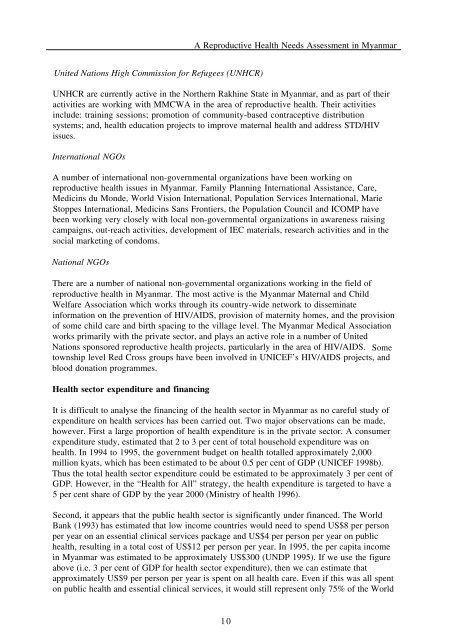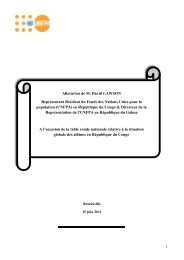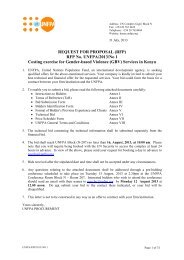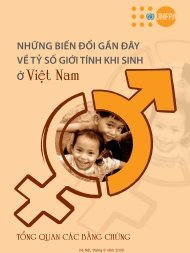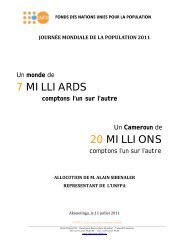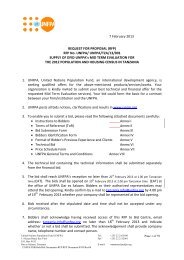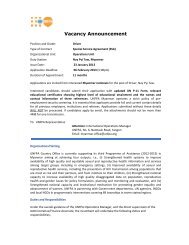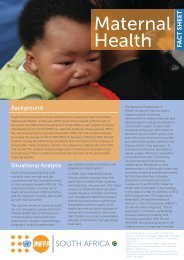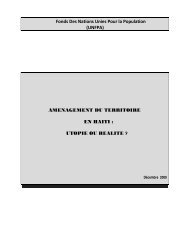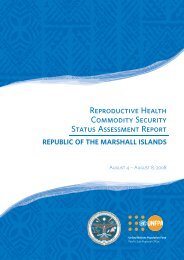A reproductive health needs assessment in Myanmar
A reproductive health needs assessment in Myanmar
A reproductive health needs assessment in Myanmar
Create successful ePaper yourself
Turn your PDF publications into a flip-book with our unique Google optimized e-Paper software.
A Reproductive Health Needs Assessment <strong>in</strong> <strong>Myanmar</strong><br />
United Nations High Commission for Refugees (UNHCR)<br />
UNHCR are currently active <strong>in</strong> the Northern Rakh<strong>in</strong>e State <strong>in</strong> <strong>Myanmar</strong>, and as part of their<br />
activities are work<strong>in</strong>g with MMCWA <strong>in</strong> the area of <strong>reproductive</strong> <strong>health</strong>. Their activities<br />
<strong>in</strong>clude: tra<strong>in</strong><strong>in</strong>g sessions; promotion of community-based contraceptive distribution<br />
systems; and, <strong>health</strong> education projects to improve maternal <strong>health</strong> and address STD/HIV<br />
issues.<br />
International NGOs<br />
A number of <strong>in</strong>ternational non-governmental organizations have been work<strong>in</strong>g on<br />
<strong>reproductive</strong> <strong>health</strong> issues <strong>in</strong> <strong>Myanmar</strong>. Family Plann<strong>in</strong>g International Assistance, Care,<br />
Medic<strong>in</strong>s du Monde, World Vision International, Population Services International, Marie<br />
Stoppes International, Medic<strong>in</strong>s Sans Frontiers, the Population Council and ICOMP have<br />
been work<strong>in</strong>g very closely with local non-governmental organizations <strong>in</strong> awareness rais<strong>in</strong>g<br />
campaigns, out-reach activities, development of IEC materials, research activities and <strong>in</strong> the<br />
social market<strong>in</strong>g of condoms.<br />
National NGOs<br />
There are a number of national non-governmental organizations work<strong>in</strong>g <strong>in</strong> the field of<br />
<strong>reproductive</strong> <strong>health</strong> <strong>in</strong> <strong>Myanmar</strong>. The most active is the <strong>Myanmar</strong> Maternal and Child<br />
Welfare Association which works through its country-wide network to dissem<strong>in</strong>ate<br />
<strong>in</strong>formation on the prevention of HIV/AIDS, provision of maternity homes, and the provision<br />
of some child care and birth spac<strong>in</strong>g to the village level. The <strong>Myanmar</strong> Medical Association<br />
works primarily with the private sector, and plays an active role <strong>in</strong> a number of United<br />
Nations sponsored <strong>reproductive</strong> <strong>health</strong> projects, particularly <strong>in</strong> the area of HIV/AIDS. Some<br />
township level Red Cross groups have been <strong>in</strong>volved <strong>in</strong> UNICEF’s HIV/AIDS projects, and<br />
blood donation programmes.<br />
Health sector expenditure and f<strong>in</strong>anc<strong>in</strong>g<br />
It is difficult to analyse the f<strong>in</strong>anc<strong>in</strong>g of the <strong>health</strong> sector <strong>in</strong> <strong>Myanmar</strong> as no careful study of<br />
expenditure on <strong>health</strong> services has been carried out. Two major observations can be made,<br />
however. First a large proportion of <strong>health</strong> expenditure is <strong>in</strong> the private sector. A consumer<br />
expenditure study, estimated that 2 to 3 per cent of total household expenditure was on<br />
<strong>health</strong>. In 1994 to 1995, the government budget on <strong>health</strong> totalled approximately 2,000<br />
million kyats, which has been estimated to be about 0.5 per cent of GDP (UNICEF 1998b).<br />
Thus the total <strong>health</strong> sector expenditure could be estimated to be approximately 3 per cent of<br />
GDP. However, <strong>in</strong> the “Health for All” strategy, the <strong>health</strong> expenditure is targeted to have a<br />
5 per cent share of GDP by the year 2000 (M<strong>in</strong>istry of <strong>health</strong> 1996).<br />
Second, it appears that the public <strong>health</strong> sector is significantly under f<strong>in</strong>anced. The World<br />
Bank (1993) has estimated that low <strong>in</strong>come countries would need to spend US$8 per person<br />
per year on an essential cl<strong>in</strong>ical services package and US$4 per person per year on public<br />
<strong>health</strong>, result<strong>in</strong>g <strong>in</strong> a total cost of US$12 per person per year. In 1995, the per capita <strong>in</strong>come<br />
<strong>in</strong> <strong>Myanmar</strong> was estimated to be approximately US$300 (UNDP 1995). If we use the figure<br />
above (i.e. 3 per cent of GDP for <strong>health</strong> sector expenditure), then we can estimate that<br />
approximately US$9 per person per year is spent on all <strong>health</strong> care. Even if this was all spent<br />
on public <strong>health</strong> and essential cl<strong>in</strong>ical services, it would still represent only 75% of the World<br />
10


